Introduction#
Welcome to spam#
Welcome to spam – The Software for the Practical Analysis of Materials.
This is a Python package for handling and correlating 3D fields for applications in material science. Spam has evolved to cover needs of data analysis from 3D x-ray tomography work and correlated random fields with mechanical applications. Spam is first and foremost a measurement package, and is divided into the following toolkits:
DICanddeformation: Tools for measuring the transformation between 2D and 3D images, containing a non-rigid image correlation engine
label: Toolkit to measure and manipulate labelled images, where discrete particles are labelled with integer voxel patches
mesh: Toolkit for generating and manipulation 3D spatial meshes. In spam tetrahedral meshes are principally used
kalisphera: Toolkit for generating analytical partial volume spheres, useful for testing
excursions: Toolkit for the excursion set of correlated random fields theory
Please see Tools provided below for a few examples of how spam has been used in published literature. You’ll find more in-depth discussion in the various Tutorials which introduce our Python function and our more complex scripts, and downloadable ready-to run examples of the Python functions provided in the Gallery of Examples. Don’t forget to browse what Python functions are available in the module index.
Please follow the Installation instructions to install spam.
How to cite spam#
If you find this project useful, please cite:
Stamati et al., (2020). spam: Software for Practical Analysis of Materials. Journal of Open Source Software, 5(51), 2286, https://doi.org/10.21105/joss.02286
Come and Chat!#
At the moment spam is principally developed by Edward Andò, Rémi Cailletaud, Emmanuel Roubin, Olga Stamati and Gustavo Pinzon, contributions are welcome! Head over to How to Contribute to find out more.
Spam is built on top of NumPy and SciPy, and has some optimised C/C++ functions for speed.
There is a element.io/matrix.org chat room for spam, please join it here and come and talk to us – it is easy, there is a chat script that can run in your web broswer. All you need to do is choose a user name!
Issues?#
If you have issues using spam, or if you find a bug, please create an issue on our gitlab.
Tools provided#
Image correlation/deformation toolkit#
Tools for measuring the transformation between 2D and 3D images.
There is a tutorial to the deformation function Φ and some examples of image correlation (both with Python functions and with scripts): Tutorial: Image correlation – Theory.
There is a specific toolkit called deformation to help with computing, decomposing and manipulating Φ.
This toolkit contains functions for computing Φ from a displacement field, and tools for computing strains – please see the Tutorial: Strain calculation for more information.
The correlation library includes a number of simple Python functions that can be called manually (most conveniently within an iPython context) such as spam.DIC.register, as well as more complex scripts, see Scripts in spam.
The local correlation script uses a regular grid of squares/cubes (see Tutorial: Image correlation – Practice), here is a published example:
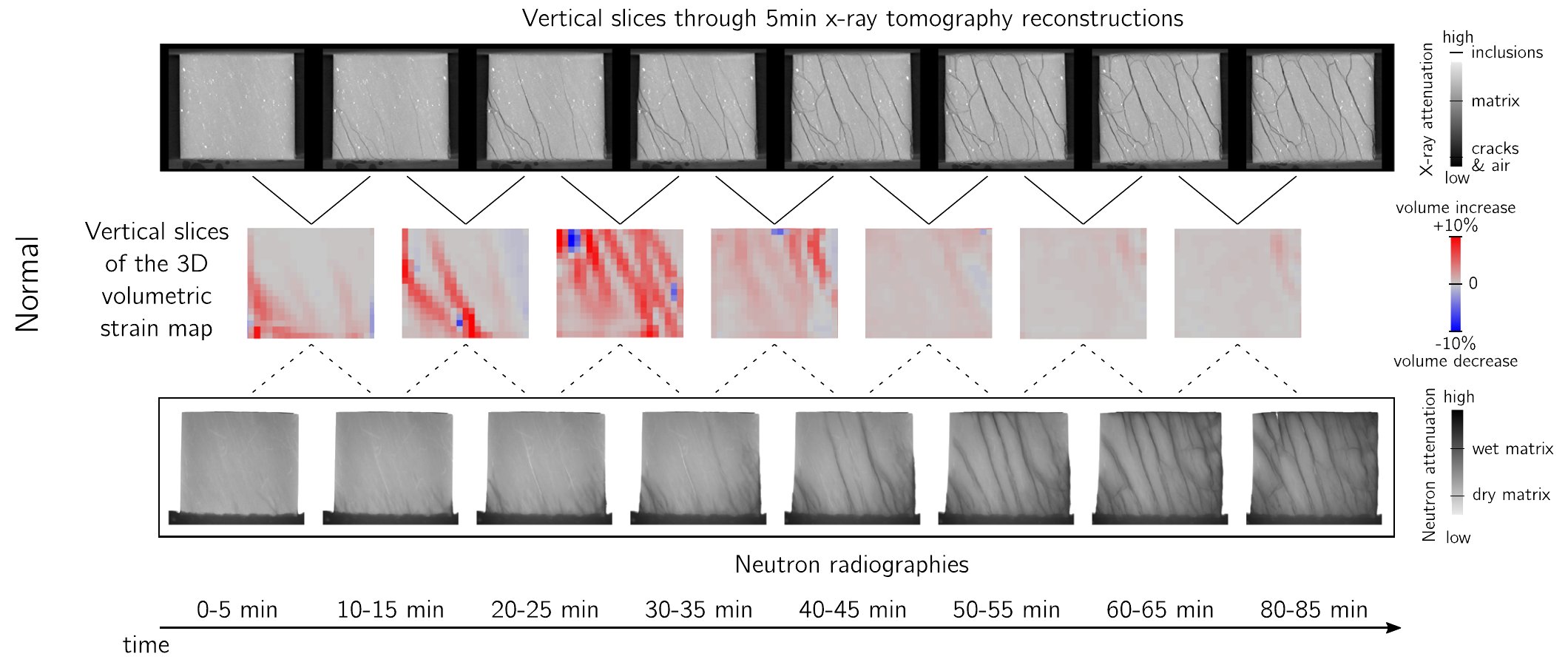
Volumetric strain results from [Stavropoulou2018] of an unconfined Callovo-Oxfordian clay rock cracking from water uptake#
The discrete correlation script operates label-by-label on a labelled volume (see Tutorial: Discrete Image correlation), here is a published example:
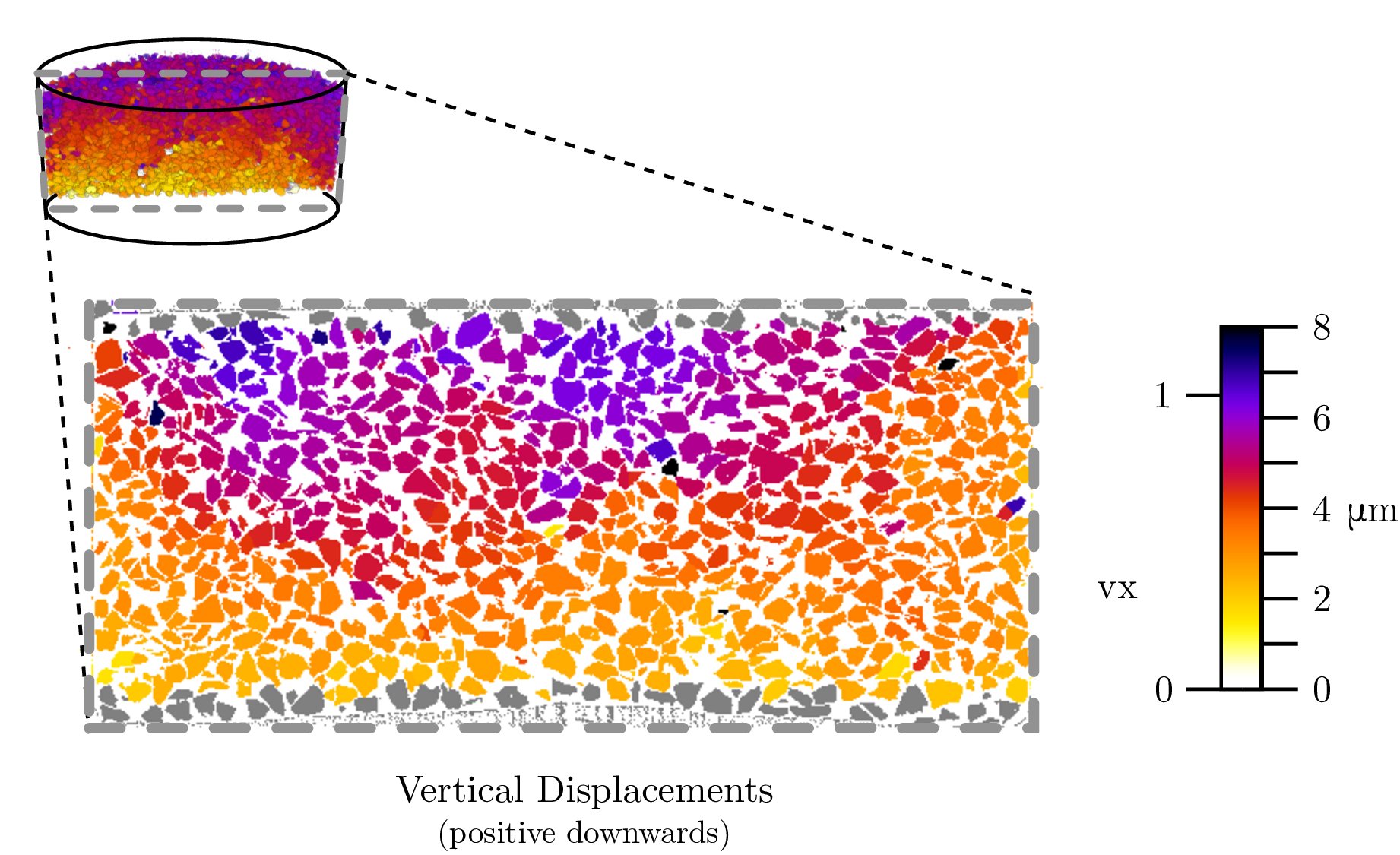
Example of discrete correlation from [Ando2019], showing grains coloured by their measured vertical displacement#
A global DIC script (which solves a global correlation problem on a mesh) also exists, but is still being tested. This has been used (carefully…) for the following publication:

Global displacement field and nodal displacements from [Stavropoulou2020]#
We also have an implementation for a multimodal registration algorithm [Tudisco2017] to align two images of the same object acquired with different modalities. Here is a published result:
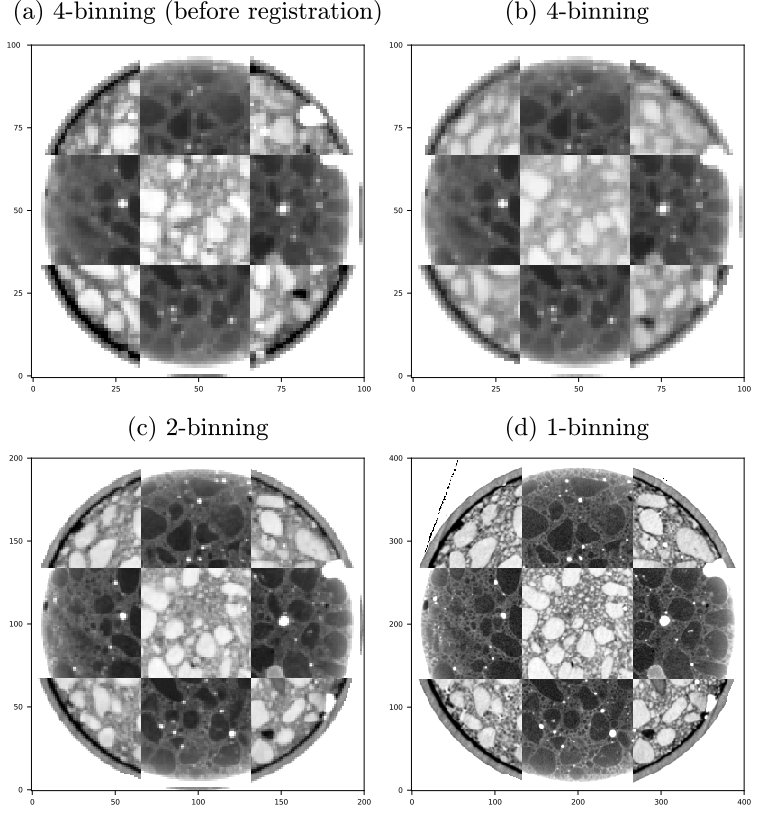
X-rays and Neutron tomography of a concrete specimen from [Roubin2019]#
Here is a graphical toolkit to help with initial alignment and other functions such as peak fitting:
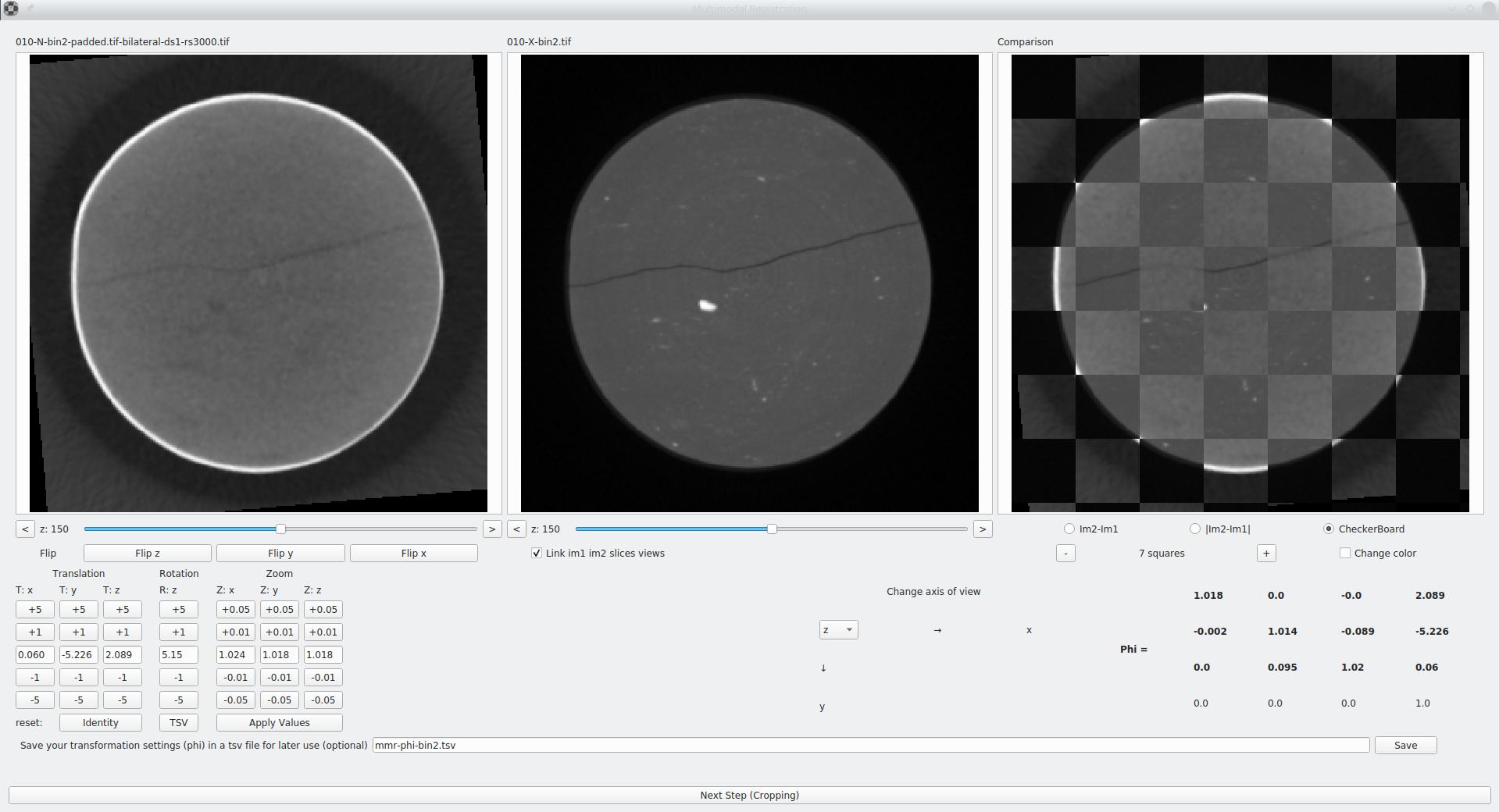
Example of the first step of spam-mmr-graphical#
Label toolkit#
Tools to deal with labelled images (of particles) where 3D images are provided. In these images, voxels are “labelled” with integer values that indicate what particle they belong to. Please see the Tutorial: Label Toolkit.
For example we offer a significantly faster (and much less memory demanding) calculation of centres of mass in a labelled image compared to scipy.ndimage.center_of_mass.
- Also offered are calculations of:
the volume of each label
the centre of mass of each label
the eigen-vectors and eigen values of the moment of inertia tensor of each label (convenient for orienting simple shapes in 3D)
the length of the half-axes of an ellipse fitting the particle
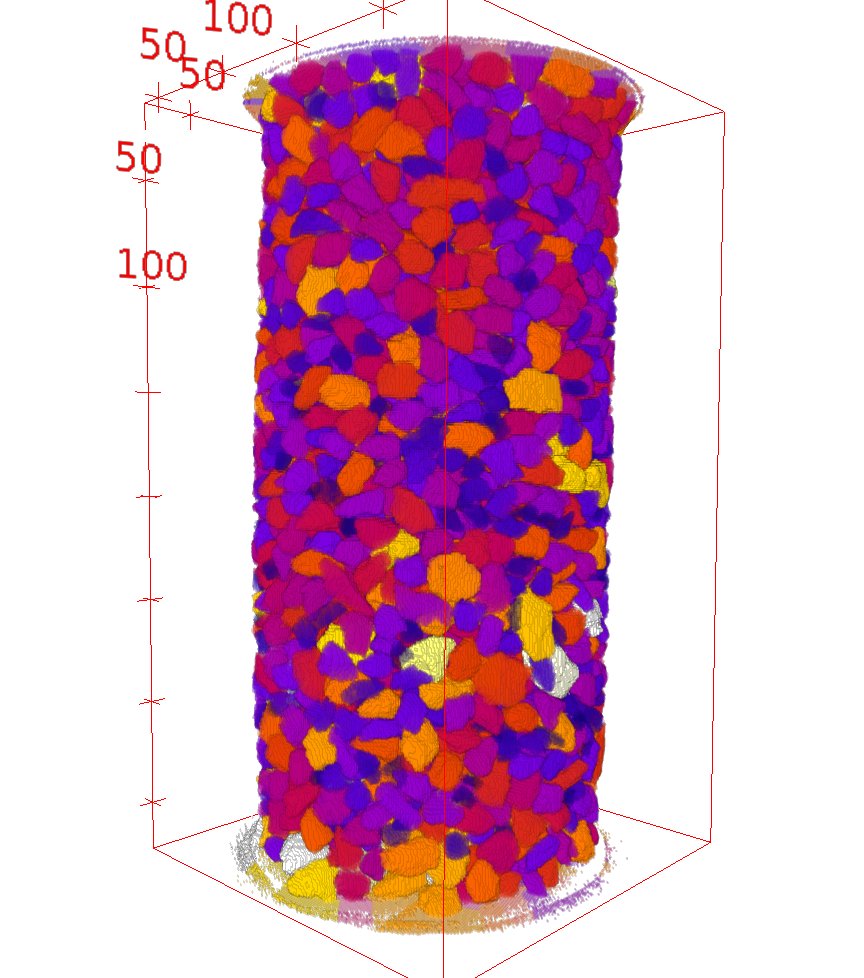
Example of discrete measurements: here grains are coloured according to their volume#
Mesh tools#
Tools to generate and manipulate meshes (random meshes, Delaunay triangulations). In spam tetrahedral meshes are principally used. You can also find tools to project morphologies onto meshes which is detailed in the Tutorial: Projection of morphologies onto a FE mesh, and can be seen in an example below:
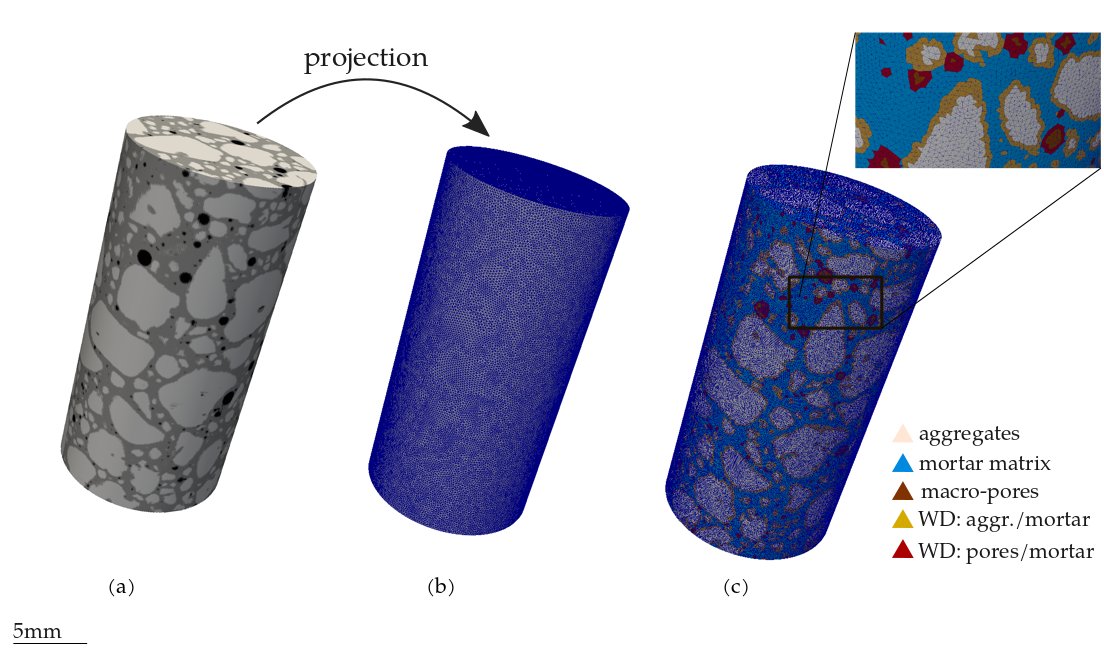
Example of the projection of a microstructure identified from tomography onto a finite-element mesh [Stamati2018b]#
Plotting tools#
These tools contain standard and generally useful plotting tools. For example:
orientationPlotter#
This function allows distributions of 3D orientations to be visualised. It puts all 3D unit vectors onto the origin (so that the set of all possible unit vectors represents a sphere) and looks at the sphere from the +z-axis. All -z orientations are flipped, and the projection of the sphere onto the plane is an equal-area project, making it easier to detect clusters. A binning function is also provided to allow more subtle trends to be detected.
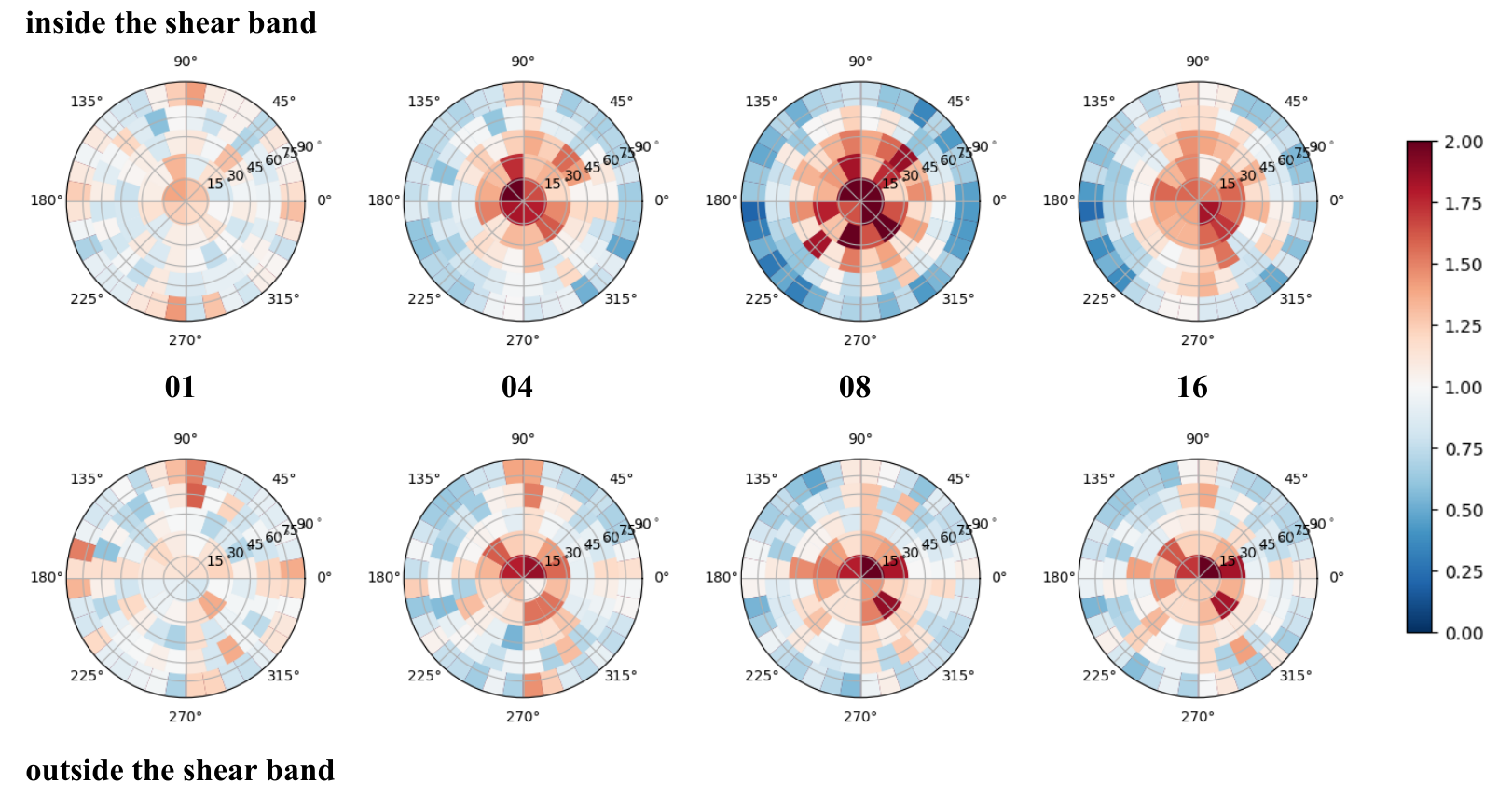
Figure showing evolving contact orientations in a triaxial test on sand from [Wiebicke2020]#
Kalisphera#
Kalisphera, a standalone analytical tool for the exact calculation of the partial volume effect of a sphere is also included in spam.
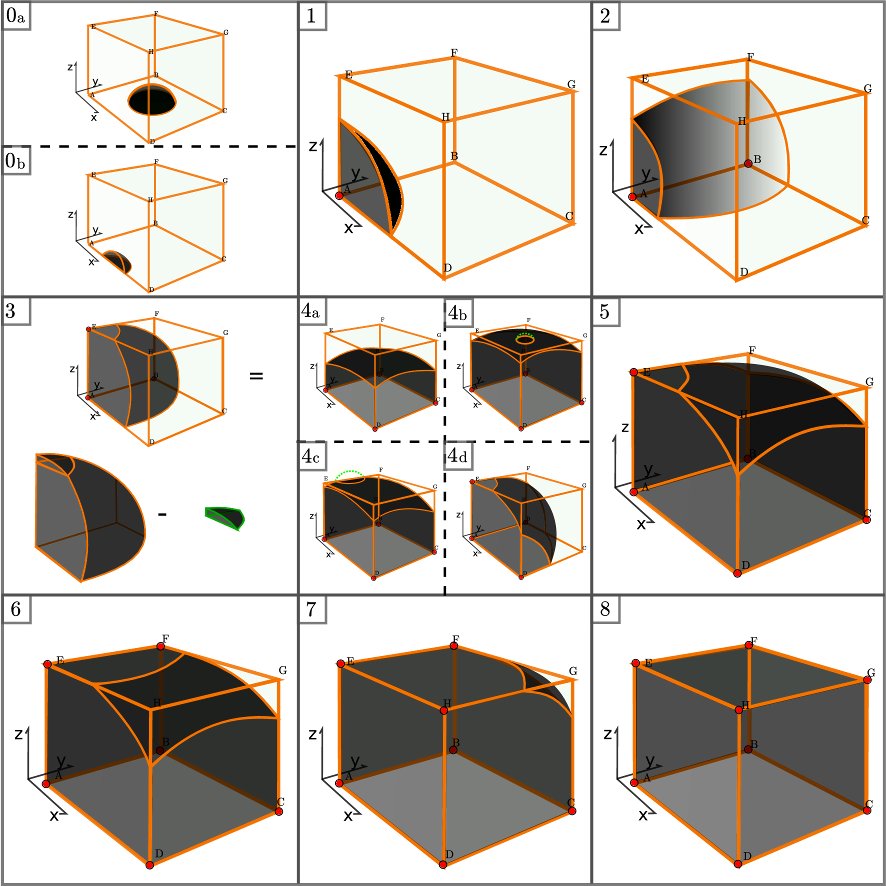
Illustration of the different analytical cases of a sphere intersection with a cube that are solved to calculate the exact partial volume effect on the edge of a sphere in Kalisphera [Tengattini2015]#
It has been imported into this project for convenience for potential users, but also because it helps in the testing of some functions (the label ones for example). Here we use Félix Bertoni’s C++ version through a Python helper function.
Below, for example, Kalisphera is used as a ground truth to which controlled measurement errors (blur and greyscale noise) are added to assess downstream errors in the analysis of contacts between spherical particles.
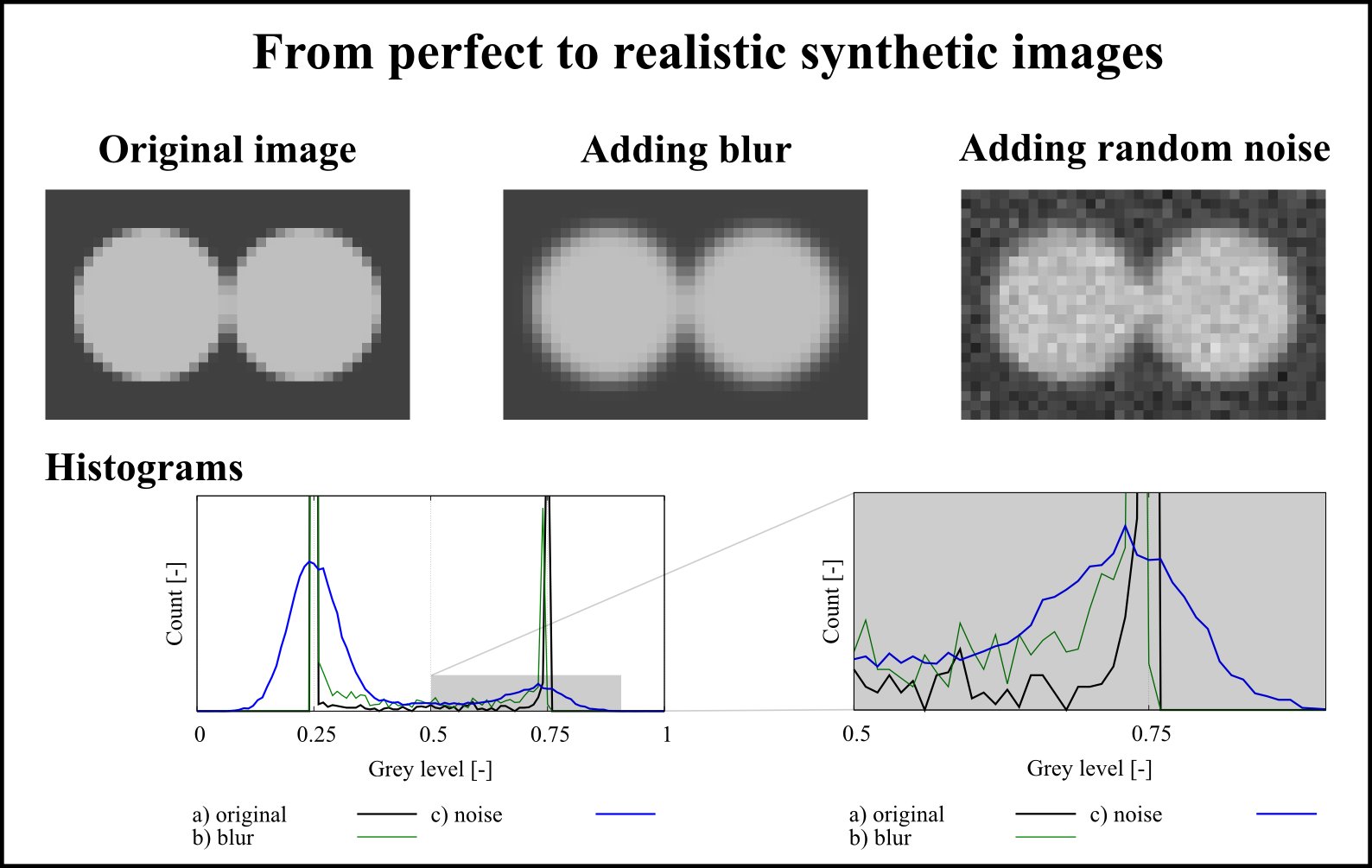
Simulation of measurement noise based on Kalisphera for a metrological study in [Wiebicke2017]#
There is also a live example where you can see the generation of a synthetic image from DEM data: Kalisphera sphere assembly generation
Helper tools#
This series of functions do generally useful and boring stuff like reading and writing files in a formatted way.
References#
Andò, E., Dijkstra, J., Roubin, E., Dano, C., & Boller, E. (2019). A peek into the origin of creep in sand. Granular Matter, 21(1), 11. https://doi.org/10.1007/s10035-018-0863-5
Kawamoto, R., Andò, E., Viggiani, G., & Andrade, J. E. (2016). Level set discrete element method for three-dimensional computations with triaxial case study. Journal of the Mechanics and Physics of Solids, 91, 1-13. https://doi.org/10.1016/j.jmps.2016.02.021
Stamati, O., Roubin, E., Andò, E., & Malecot, Y. (2018). Tensile failure of micro-concrete: from mechanical tests to FE meso-model with the help of X-ray tomography. Meccanica, 1-16. https://doi.org/10.1007/s11012-018-0917-0
Stavropoulou, E., Andò, E., Tengattini, A., Briffaut M., Dufour, F., Atkins, D., Armand, G. (2018). Liquid water uptake in unconfined Callovo Oxfordian clay-rock studied with neutron and X-ray imaging. Acta Geotechnica. https://doi.org/10.1007/s11440-018-0639-4
Stavropoulou, E., Andò, E., Roubin, E., Lenoir, N., Tengattini, A., Briffaut, M., & Bésuelle, P. (2020). Dynamics of water absorption in Callovo-Oxfordian Claystone revealed with multimodal x-ray and neutron tomography. Frontiers in Earth Science, 8, 6. https://dx.doi.org/10.3389/feart.2020.00006
Tengattini, A., & Andò, E. (2015). Kalisphera: an analytical tool to reproduce the partial volume effect of spheres imaged in 3D. Measurement Science and Technology, 26(9), 095606. https://doi. org/10.1088/0957-0233/26/9/095606
Tudisco, E., Jailin, C., Mendoza, A., Tengattini, A., Andò, E., Hall, S. A., … & Roux, S. (2017). An extension of digital volume correlation for multimodality image registration. Measurement Science and Technology, 28(9), 095401. https://doi.org/10.1088/1361-6501/aa7b48
Roubin, E., Andò, E., & Roux, S. (2019). The colours of concrete as seen by X-rays and neutrons. Cement and Concrete Composites, 104, 103336. https://doi.org/10.1016/j.cemconcomp.2019.103336
Wiebicke, M., Andò, E., Herle, I., & Viggiani, G. (2017). On the metrology of interparticle contacts in sand from x-ray tomography images. Measurement Science and Technology, 28(12), 124007. https://doi.org/10.1088/1361-6501/aa8dbf
Wiebicke, M., Andò, E., Viggiani, G., & Herle, I. (2020). Measuring the evolution of contact fabric in shear bands with X-ray tomography. Acta Geotechnica, 15(1), 79-93. https://doi.org/10.1007/s11440-019-00869-9
